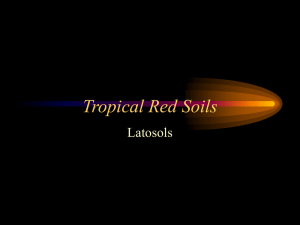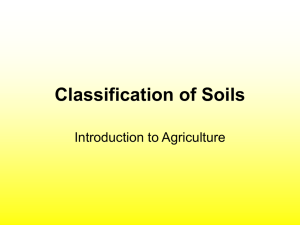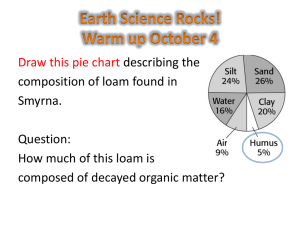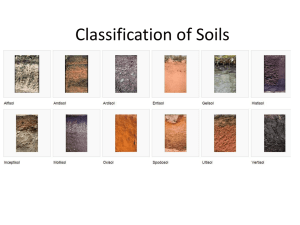Soil Formation - Warta MHS Science
advertisement
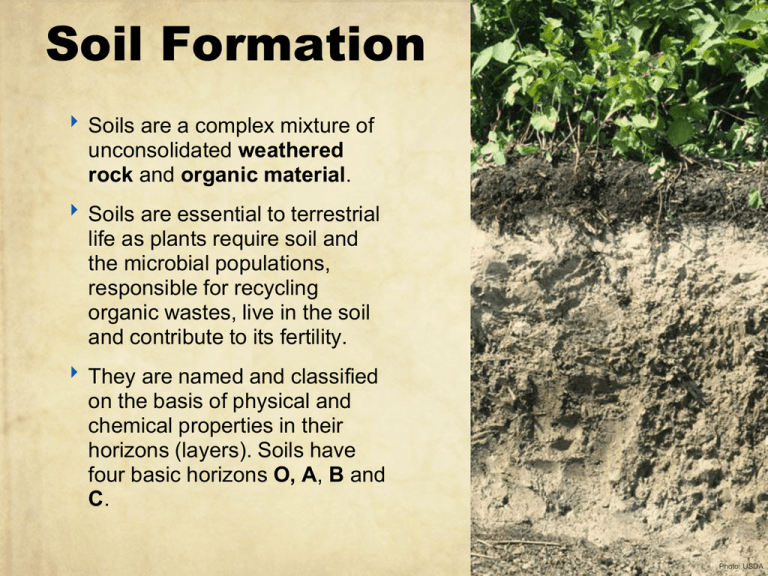
Soil Formation ‣ Soils are a complex mixture of unconsolidated weathered rock and organic material. ‣ Soils are essential to terrestrial life as plants require soil and the microbial populations, responsible for recycling organic wastes, live in the soil and contribute to its fertility. ‣ They are named and classified on the basis of physical and chemical properties in their horizons (layers). Soils have four basic horizons O, A, B and C. Photo: USDA Soil Formation ‣ The O horizon is the organic O layer, rich in humus. This is where you find leaf litter, dead plants and animals that are just beginning to decompose ‣ The A horizon is the topsoil, B which is rich in organic matter. The dark color of the topsoil is due to the carbon in the decomposing organic material. ‣ The B horizon is a subsoil C containing clay and soluble minerals. ‣ The C horizon is made up of weathered parent material and rock fragments. Soil Formation Stage 1 Stage 2 Stage 3 Stage 4 O horizon Disintegrating parent rock Weathered parent rock (C horizon) A horizon B horizon Bedrock C horizon Bedrock C horizon Bedrock Bedrock Soil Formation ‣ The parent rock is broken Disintegrating parent rock down by weathering to form a regolith , which overlies the solid bedrock. ‣ The soil that forms is part of the regolith. Bedrock Soil Formation Layer of organic matter or O horizon ‣ Plants begin to establish and organic material builds up on the surface. ‣ The organic material aids Weathered parent rock (C horizon) the disintegration of the parent material. Bedrock Soil Formation Mineral fragments and organic matter O horizon Humus Topsoil ‣ Horizons form as the mineral and organic content mix. C horizon ‣ Humus rich layers are at the surface and mineral rich layers are at the base. Bedrock Soil Formation O horizon ‣ Horizons are well developed in mature soils. ‣ The final characteristics of the soil are determined by the regional conditions and the rock type. Subsoil B horizon C horizon Bedrock Soil Development ‣ The character and composition of the parent material is important in determining the properties of a soil. ‣ Parent materials include volcanic deposits, and sediments deposited by wind, water, or glaciers. Soil Development ‣ The occurrence of freezethaw and wet-dry cycles, as well as average temperature and moisture levels are important in the development of soils. ‣ Climate also affects vegetation, influencing soil development. Soil Development ‣ Plants, animals, fungi, and bacteria help to create a soil both through their activities and by adding to the soil's organic matter when they die. ‣ Moist soils with a high organic content tend to be higher in biological activity. Soil Development ‣ The topography of the land influences soil development by affecting soil moisture and tendency towards erosion. ‣ Soils in steep regions are more prone to loss of the topsoil and erosion of the subsoil. Climatic Influence on Soil ARID Desert soils These are alkaline mineral soils with variable amounts of clay, low levels of organic matter, and poorly developed vertical profiles. Horizon A Horizon A Horizon B Horizon B HUMID Photo: USDA Tropical soils Leaching and chemical weathering make these soils acidic. Aluminum and iron oxides accumulate in the deep B horizon. Photo: USDA Climatic Influence on Soil MID-LATITUDE Grassland soils Mature, alkaline, deep, well drained soils. They are typically nutrient-rich and productive with a high organic content. Horizon A Horizon A Horizon B Horizon B POLAR Very low temperatures slow the decomposition of organic matter and maintain the permafrost layer in these frozen soils. Photo: USDA Photo: USDA Climatic Influence on Soil Horizon A Horizon B TEMPERATE Weathered forest soils Well developed soils with a deep organic layer and accumulated clay at lower levels. Horizon A Horizon B SEASONALLY WET Swelling soils Marked seasonal rainfall results in deep cracks as the soil alternately swells and shrinks. Photo: USDA Photo: USDA ‣ ‣ Photo:Siim Sepp, Creative Commons share alike 3.0 Particle Size Soils are made of many different sized mineral particles and other material, but the grains in them can be placed into categories based on size. The combination of sizes gives the soil its texture. Clay: particle diameter < 0.002mm Photo: Infrogmation, Creative Commons share alike 2.5 Photo: Bobannye Sand: particle diameter 0.05mm > 2mm Silt: particle diameter 0.05mm > 0.002mm Soil Texture ‣ Soil texture depends upon the amount of sand, silt and clay present. 90 10 80 20 70 30 Read silt in this direction Clay The optimal soil texture is called a loam and is around 40% sand, 40% silt and 20% clay. 60 50 40 30 Other loam exist but are named after their various components. 40 50 Sandy clay Silty clay Silty clay loam Clay loam Sandy clay loam 60 70 20 Read clay in this direction 80 Loam 10 Silt loam Sandy loam 90 Silt Sand 90 80 Loamy sand 70 60 50 40 Percentage sand 30 20 10 Read sand in this direction

